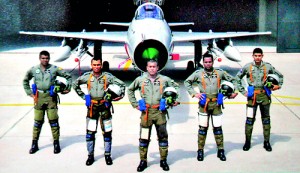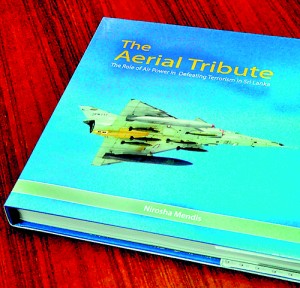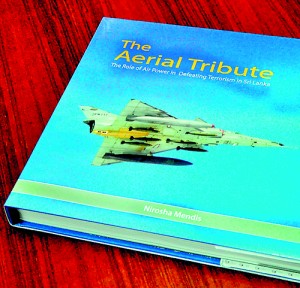Sunday Times 2
The Aerial Tribute
Stepping away from his field of medicine Dr. Nirosha Mendis has authored “The Aerial Tribute- The Role of Air Power in Defeating Terrorism in Sri Lanka” an in-depth account and insight into the air strategy formulated by the Sri Lanka Air Force (SLAF) during the final years of the 30- year civil war. In seven detailed chapters the book provides a telescopic view of Eelam War IV (26 July 2006- 19 May 2009) with a collection of stunning graphics and photographs courtesy of the Air Force with never before seen footage of the war.
For Dr. Mendis the experience has been nothing short of incredible. A medical practitioner, member of the Royal College of  Psychiatrists and current director of the National Council for Mental Health he has authored several books in the past, but this is his first away from the field of medicine. Having been asked to undertake the task of writing the book by the former Commander of the SLAF Air Marshal Harsha Abeywickrama, Dr. Mendis, an avid aviation and military enthusiast lost no time in getting arm deep in research for the project. Wanting to provide his readers with a factual, unbiased outlook of the air strategy adopted by the SLAF during the Humanitarian Operation he spent over six months travelling around camps, reading and researching. “I’ve known a lot of officers who gave me a lot of material,” he explained; that he was also very up to date on the subject also helped.
Psychiatrists and current director of the National Council for Mental Health he has authored several books in the past, but this is his first away from the field of medicine. Having been asked to undertake the task of writing the book by the former Commander of the SLAF Air Marshal Harsha Abeywickrama, Dr. Mendis, an avid aviation and military enthusiast lost no time in getting arm deep in research for the project. Wanting to provide his readers with a factual, unbiased outlook of the air strategy adopted by the SLAF during the Humanitarian Operation he spent over six months travelling around camps, reading and researching. “I’ve known a lot of officers who gave me a lot of material,” he explained; that he was also very up to date on the subject also helped.
The book provides a technical and factual overview of the work done by the Air Force; interesting additions include accounts by various high officials from the three forces. Interesting trivia about military personnel and operations along with summaries, charts and tables make understanding the complex detailed missions easier for the reader.
 Dr. Mendis says he chose to observe the entire military and political system from as unbiased a point of view as possible. “I had never worked with the Air Force or had any connection to it previously,” he stated which helped with his task as a third party observer watching the events unfold. “The fact that the Air Force had to support the Navy and the Army was a tremendous task itself,” he says adding that most people, including the forces themselves don’t know and appreciate half of the mammoth task undertaken by the Air Force during the final stages of the conflict.
Dr. Mendis says he chose to observe the entire military and political system from as unbiased a point of view as possible. “I had never worked with the Air Force or had any connection to it previously,” he stated which helped with his task as a third party observer watching the events unfold. “The fact that the Air Force had to support the Navy and the Army was a tremendous task itself,” he says adding that most people, including the forces themselves don’t know and appreciate half of the mammoth task undertaken by the Air Force during the final stages of the conflict.
As an observer of the war on terror growing up during the war years, Dr. Mendis says his personal view on the forces changed immensely over time. Describing the leadership and the work ethic in the armed forces he feels that the Air Force has transformed from a traditional symbol to a professional and highly efficient work force. “Looking at the workings of the Air Force there was a lot of technology used in the strategies,” he explained applauding Air Marshal Harsha Abeywickrama who revolutionised the SLAF air strategy with the introduction of the Network Centric Software (NCW) concept and bold practical decision making.
The beauty of the Air Force, for him is in the attitudes of the officers and their leaders who saw the entire process through regardless of the multitude of obstacles in their path. “For example, we had Indian trained pilots flying Russian planes fitted with Chinese bombs,” he added.
While he was dedicated to documenting the processes of the SLAF during the war without fanfare, the commitment and efficiency of the pilots was a factor that really struck a chord with the author. “They are the unsung heroes,” he states explaining the high pressures of their job and the challenges of not having any sort of life away from their flying.
The leadership behind the Air Force was a pillar for the entire militia, he feels.
For Dr. Mendis the visits he made to Air Force bases and camps not only provided the technical know-how needed for the book but also opened his eyes to the extensive organisation and thoughtful care put in by the higher officials. “All the little things that made a difference in the soldiers’ day-to-day lives were thought of,” explained the author. Describing the unwavering support of the military leaders toward the force he was impressed by the motivation and attitudes shown by the authorities. “Gone are the days where the hierarchy was about their own personal comfort,” he says.
The final section of his book is dedicated to the dynamic higher officials whose leadership was an undeniable asset to the SLAF. “I hope this book will be a fitting tribute to those in the SLAF that made the difference and won the peace for all,” he writes in the book.
Six months and 330 pages later Dr. Mendis and the SLAF can look back with justifiable pride at this handsome book with so much invaluable knowledge bound up within its hard cover. “The book I think is important even for the future generation,” reflects the author. “They need to know exactly what happened and how it happened and learn from both our successes and failures.”
“An Aerial Tribute” by Dr. Nirosha Mendis, published by the Sri Lanka Air Force will be available for purchase online and at the Air Force Museum for serving members at Rs 2,000 for one copy only, and for others at Rs. 5,000 per copy. Proceeds from its sale will go the Command welfare Fund of the SLAF.


